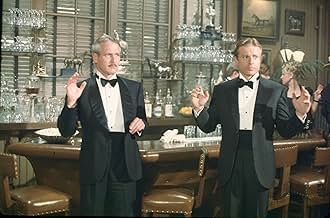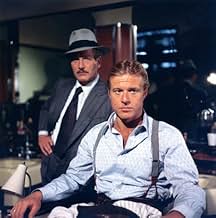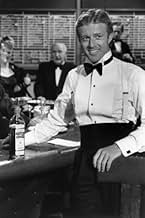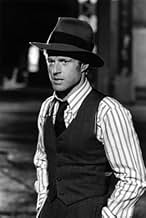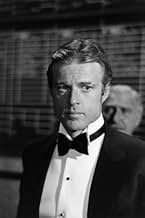सितंबर 1936 में शिकागो में, एक युवा ठग अपने हत्यारे साथी का बदला लेने के लिए एक आपराधिक बैंकर से भाग्य जीतने के लिए बड़े कॉन के एक मास्टर के साथ मिलकर काम करता है।सितंबर 1936 में शिकागो में, एक युवा ठग अपने हत्यारे साथी का बदला लेने के लिए एक आपराधिक बैंकर से भाग्य जीतने के लिए बड़े कॉन के एक मास्टर के साथ मिलकर काम करता है।सितंबर 1936 में शिकागो में, एक युवा ठग अपने हत्यारे साथी का बदला लेने के लिए एक आपराधिक बैंकर से भाग्य जीतने के लिए बड़े कॉन के एक मास्टर के साथ मिलकर काम करता है।
- 7 ऑस्कर जीते
- 18 जीत और कुल 6 नामांकन
Robert Earl Jones
- Luther Coleman
- (as Robertearl Jones)
James Sloyan
- Mottola
- (as James J. Sloyan)
सारांश
Reviewers say 'The Sting' is celebrated for its intricate plot, charismatic performances by Paul Newman and Robert Redford, and nostalgic charm of the 1930s setting. The film's clever con schemes, dynamic character interactions, and witty dialogue are frequently highlighted. The iconic ragtime music enhances the atmosphere, while meticulous production design immerses viewers. Despite some criticisms regarding historical inaccuracies and predictability, 'The Sting' is widely regarded as a timeless classic.
फ़ीचर्ड समीक्षाएं
Small time conmen Johnny Hooker and Luther Coleman unwittingly scam a runner for Chicago main man Doyle Lonnegan. When Luther is murdered, Hooker goes on the run and seeks out Luther's old friend Henry Gondorff to help him put together a major sting to take revenge on Lonnegan. However with so much heat on Hooker and the stakes so high can they pull it off and get away clean?
Almost a follow up to Butch and Sundance, this film partners the stars of the day Newman and Redford to good effect. The story is a little less fun but still very enjoyable to watch as it builds to a great finale. The use of chapters ran the risk of fragmenting the film into bits but instead it really helps set it out and makes it more manageable. Although it is not as light hearted and jovial as the theme music suggests it still manages to flow nicely with the slightly darker drama not spoiling anything but only serving to make it feel more grown up.
The cast are all very good and make the film easy to watch. Redford comes off the best in terms of characters and his role really suits both his carefree attitude (the start of the film) but also his more serious side (the rest of the film). Newman has a lesser role that perhaps doesn't suit him quite as well, but he does have several really good scenes (the hustles) where he does very good work. Shaw's accent is a little heavy at first but I got used to it and it worked for me and he was a really good foil for Redford/Newman. The support cast including Durning, Walston, Gould, Jones and others all do good work.
The direction and use of music is really good and the sense of period is well crafted and doesn't just feel like it was painted on. I'm not sure if it deserved Best Picture or not because I don't know what the rest of the field was for that year but it is a really enjoyable film that is quite fun to watch several times even 30 years later and isn't that the main thing?
Almost a follow up to Butch and Sundance, this film partners the stars of the day Newman and Redford to good effect. The story is a little less fun but still very enjoyable to watch as it builds to a great finale. The use of chapters ran the risk of fragmenting the film into bits but instead it really helps set it out and makes it more manageable. Although it is not as light hearted and jovial as the theme music suggests it still manages to flow nicely with the slightly darker drama not spoiling anything but only serving to make it feel more grown up.
The cast are all very good and make the film easy to watch. Redford comes off the best in terms of characters and his role really suits both his carefree attitude (the start of the film) but also his more serious side (the rest of the film). Newman has a lesser role that perhaps doesn't suit him quite as well, but he does have several really good scenes (the hustles) where he does very good work. Shaw's accent is a little heavy at first but I got used to it and it worked for me and he was a really good foil for Redford/Newman. The support cast including Durning, Walston, Gould, Jones and others all do good work.
The direction and use of music is really good and the sense of period is well crafted and doesn't just feel like it was painted on. I'm not sure if it deserved Best Picture or not because I don't know what the rest of the field was for that year but it is a really enjoyable film that is quite fun to watch several times even 30 years later and isn't that the main thing?
I agree 100 percent that this is a wonderful movie. I first saw it over 30 years ago, and it remains vivid in my mind while I can't remember zip about movies I saw last week which others have praised and I found wanting. I can't think of another film about double and triple crosses that deserves to be mentioned in the same sentence with "The Sting" (which doesn't mean that some of the others haven't been good). In addition to all the things that others have praised, one of the most memorable features of this film is the use of a Scott Joplin rag, which both lends a distinctive period touch and adds a sense of fast-paced motion to the action. I'm not much for ranking films -- top five, top ten, top 250 -- but this is one of the best. If you haven't already seen it, drop everything and find the DVD. As pure entertainment, it can't be beat.
10moman818
A magical plot, dead on art direction, brilliant supporting roles (most notably Robert Shaw, ya falla?), and the guiding hand of Redford/Newman chemistry make this one of the Hollywood's great films. "The Sting" is a hallmark of the "Golden Age" of American film, and has molded not only countless films, but numerous genres, few of which have met the challenge of its master.
At first sight, THE STING appears to be nothing more than a television movie. It is entirely plot-driven with no real stand out characters or personalities. What makes the film work is excellent production design and a delightfully clever plot filled with many surprises. The movie is feather-weight emotionally, but the depth of the "con" and the way it is fashioned by screenwriter David Ward leaves you with a pleasant experience.
This is more Redford's film than Newman's, who reunite with George Roy Hill, director of BUTCH CASSIDY AND THE SUNDANCE KID. The legendary actors were more flesh and blood in that film, but here, they are merely players who carry the story along. With lesser actors, THE STING may have been a forgettable piece of work. Redford does all of the dirty work after Newman's initial "hook", but the omniscient presence of Newman, as big-time grifter "Henry Gondorff" exists throughout. A mysterious gloved character, a crooked cop, the FBI, and a seemingly bigger con-man "Doyle Lonnegan" (played by the late, great Robert Shaw) are some of the players who are involved in some events that seem to be manipulated by an unseen force. Is Newman as good as he claims in trying to clean out Shaw? We'll see.
The film is shot simply by Hill. No tricky angles or contrived camera movements are used. The action takes place simply in front of us. The production design by Henry Bumstead and James Payne recreates old-time Chicago through the use of built sets, matte paintings of a smaller sky-line, and some location shots. It gives the film an almost artificial look which is fitting considering it is a direct homage to the 1930's and the gangster pictures that so dominated that decade. The story is even furthered by title pages describing "the set-up, the hook, and the sting". They are turned like pages in a book, adding a drop of elegance to a crooked world. An iris is even employed in some scenes.
THE STING is definitely lightweight entertainment. It does not provoke much thought or insight into what is happening on screen. Fun is the word for this amusing little film that depicts a masterful plan for a big steal which would be impossible to pull off today. Look out for Ray Walston in a hilarious role announcing horse races and their results as they are "happening" just after receiving word of the "real" race results from a back room in the betting house. These are good con-men.
RATING: ***
This is more Redford's film than Newman's, who reunite with George Roy Hill, director of BUTCH CASSIDY AND THE SUNDANCE KID. The legendary actors were more flesh and blood in that film, but here, they are merely players who carry the story along. With lesser actors, THE STING may have been a forgettable piece of work. Redford does all of the dirty work after Newman's initial "hook", but the omniscient presence of Newman, as big-time grifter "Henry Gondorff" exists throughout. A mysterious gloved character, a crooked cop, the FBI, and a seemingly bigger con-man "Doyle Lonnegan" (played by the late, great Robert Shaw) are some of the players who are involved in some events that seem to be manipulated by an unseen force. Is Newman as good as he claims in trying to clean out Shaw? We'll see.
The film is shot simply by Hill. No tricky angles or contrived camera movements are used. The action takes place simply in front of us. The production design by Henry Bumstead and James Payne recreates old-time Chicago through the use of built sets, matte paintings of a smaller sky-line, and some location shots. It gives the film an almost artificial look which is fitting considering it is a direct homage to the 1930's and the gangster pictures that so dominated that decade. The story is even furthered by title pages describing "the set-up, the hook, and the sting". They are turned like pages in a book, adding a drop of elegance to a crooked world. An iris is even employed in some scenes.
THE STING is definitely lightweight entertainment. It does not provoke much thought or insight into what is happening on screen. Fun is the word for this amusing little film that depicts a masterful plan for a big steal which would be impossible to pull off today. Look out for Ray Walston in a hilarious role announcing horse races and their results as they are "happening" just after receiving word of the "real" race results from a back room in the betting house. These are good con-men.
RATING: ***
The fix is in, the odds are set, and the boys are ready to play for the big time, both on the screen and behind the camera in this breezy, endlessly entertaining movie classic.
Robert Redford is small-time hustler Johnny Hooker, happy to play the marks in Joliet until the murder of his mentor pushes him to go up against the nastiest mug in Chicago, Doyle Lonnegan (Robert Shaw.) Hooker'd rather ice Lonnegan outright, but will settle for a big con with the help of a slightly wobbly but game scammer named Henry Gondorff, played as only Paul Newman can.
Newman and Redford, along with director George Roy Hill, had a lot riding on this pony, given it was a follow-up to their earlier "Butch Cassidy And The Sundance Kid." To measure up, they had to produce nothing short of another classic. And so they did. "The Sting" won the Best Picture Oscar in 1973, and remains the sentimental favorite among many in choosing between the two films.
Comparing "The Sting" to "Butch Cassidy" is kind of overdone sport, and tempers, as Lonnegan would say, run hot. But you can see why "The Sting" worked as well as it did by looking at how the director and the stars played it differently within the same basic framework as "Butch Cassidy." Newman and Redford are again outlaws and underdogs. Period detail abounds here as it did with "Butch Cassidy," and there's another memorable score amid the proceedings, Scott Joplin rags modernized by Marvin Hamlisch. The score even produced another hit, "The Entertainer," to compare with "Raindrops Keep Falling On My Head."
What's different about "The Sting," and what makes it such a classic in its own right, is the way the stars service the plot. In "Butch Cassidy," Newman and Redford's comradeship was the story. Here, the chemistry between the two actors is minimized in favor of spinning a yarn with enough red herrings to feed the Swedish navy. The tale here is better than "Butch Cassidy," which is a more elegiac film with grander cinematography and funnier set pieces. "The Sting" is an edge-of-your-seat caper flick from beginning to end.
You can't really call "The Sting" a comedy. Though there are many laughs, especially when Newman hooks Shaw during a poker game, Hill won't let the audience relax enough for that. What this is is a con game, played on the audience, designed not to cheat but entertain by means of clever hoodwinking and constant misdirection plays.
You'll get no spoilers from me. This is one worth sitting through with no expectations. Five gets you ten you'll enjoy Newman and Redford, and a terrific supporting cast (one advantage over "Butch Cassidy") that includes Charles Durning, Eileen Brennan, Dana Elcar, Harold Gould, and Mr. Hand himself, Ray Walston. There's another familiar face from "Butch Cassidy," Charles Dierkop, Flat Nose Curry in "Butch Cassidy" and Lonnegan's right hand here. The best performance may be Robert Shaw's; he exudes menace aplenty but some humanity, too, when he takes Hooker under his wing after learning he came from the same hard streets of Five Points Lonnegan sprang from.
Terrific period detail, too. The dialogue is great and feels real in its Runyonesque way, while the cons are elaborate and logically played out. Watching this a second time is especially fun because once you know how the plot goes down, you find yourself catching clues you missed the first time, and enjoying the film even more for them.
Why didn't Newman and Redford team up again? Certainly there was another good movie for them to partner up in, but as Gondorff would have put it, only chumps don't quit when they're ahead.
Robert Redford is small-time hustler Johnny Hooker, happy to play the marks in Joliet until the murder of his mentor pushes him to go up against the nastiest mug in Chicago, Doyle Lonnegan (Robert Shaw.) Hooker'd rather ice Lonnegan outright, but will settle for a big con with the help of a slightly wobbly but game scammer named Henry Gondorff, played as only Paul Newman can.
Newman and Redford, along with director George Roy Hill, had a lot riding on this pony, given it was a follow-up to their earlier "Butch Cassidy And The Sundance Kid." To measure up, they had to produce nothing short of another classic. And so they did. "The Sting" won the Best Picture Oscar in 1973, and remains the sentimental favorite among many in choosing between the two films.
Comparing "The Sting" to "Butch Cassidy" is kind of overdone sport, and tempers, as Lonnegan would say, run hot. But you can see why "The Sting" worked as well as it did by looking at how the director and the stars played it differently within the same basic framework as "Butch Cassidy." Newman and Redford are again outlaws and underdogs. Period detail abounds here as it did with "Butch Cassidy," and there's another memorable score amid the proceedings, Scott Joplin rags modernized by Marvin Hamlisch. The score even produced another hit, "The Entertainer," to compare with "Raindrops Keep Falling On My Head."
What's different about "The Sting," and what makes it such a classic in its own right, is the way the stars service the plot. In "Butch Cassidy," Newman and Redford's comradeship was the story. Here, the chemistry between the two actors is minimized in favor of spinning a yarn with enough red herrings to feed the Swedish navy. The tale here is better than "Butch Cassidy," which is a more elegiac film with grander cinematography and funnier set pieces. "The Sting" is an edge-of-your-seat caper flick from beginning to end.
You can't really call "The Sting" a comedy. Though there are many laughs, especially when Newman hooks Shaw during a poker game, Hill won't let the audience relax enough for that. What this is is a con game, played on the audience, designed not to cheat but entertain by means of clever hoodwinking and constant misdirection plays.
You'll get no spoilers from me. This is one worth sitting through with no expectations. Five gets you ten you'll enjoy Newman and Redford, and a terrific supporting cast (one advantage over "Butch Cassidy") that includes Charles Durning, Eileen Brennan, Dana Elcar, Harold Gould, and Mr. Hand himself, Ray Walston. There's another familiar face from "Butch Cassidy," Charles Dierkop, Flat Nose Curry in "Butch Cassidy" and Lonnegan's right hand here. The best performance may be Robert Shaw's; he exudes menace aplenty but some humanity, too, when he takes Hooker under his wing after learning he came from the same hard streets of Five Points Lonnegan sprang from.
Terrific period detail, too. The dialogue is great and feels real in its Runyonesque way, while the cons are elaborate and logically played out. Watching this a second time is especially fun because once you know how the plot goes down, you find yourself catching clues you missed the first time, and enjoying the film even more for them.
Why didn't Newman and Redford team up again? Certainly there was another good movie for them to partner up in, but as Gondorff would have put it, only chumps don't quit when they're ahead.
Oscars Best Picture Winners, Ranked
Oscars Best Picture Winners, Ranked
See the complete list of Oscars Best Picture winners, ranked by IMDb ratings.
क्या आपको पता है
- ट्रिवियाPaul Newman and Robert Redford were each paid $500,000 for their role, the highest rate for an actor working at that time. Adjusted for inflation, that is equal to about $3 million (2022). The year before this Marlon Brando earned $3 million from Ultimo tango a Parigi (1972) but that included profit participation.
- गूफ़In the bathroom, Hooker can be seen saying, "He didn't tell me you was a fuck-up either." This has been looped to replace it with the less profane "He didn't tell me you was a screw-up either." (The grammar error is scripted.)
- भाव
Johnny Hooker: Can you get a mob together?
Henry Gondorff: After what happened to Luther, I don't think I can get more than two, three hundred guys.
- क्रेज़ी क्रेडिटThe opening animated logo for Universal Pictures is in 1930s style, matching the movie's setting, instead of the 1970s version.
- कनेक्शनFeatured in Oscars, Actors and The Exorcist (1974)
टॉप पसंद
रेटिंग देने के लिए साइन-इन करें और वैयक्तिकृत सुझावों के लिए वॉचलिस्ट करें
विवरण
- रिलीज़ की तारीख़
- कंट्री ऑफ़ ओरिजिन
- भाषा
- इस रूप में भी जाना जाता है
- El golpe
- फ़िल्माने की जगहें
- उत्पादन कंपनियां
- IMDbPro पर और कंपनी क्रेडिट देखें
बॉक्स ऑफ़िस
- बजट
- $55,00,000(अनुमानित)
- US और कनाडा में सकल
- $15,60,00,000
- दुनिया भर में सकल
- $15,60,00,000
- चलने की अवधि2 घंटे 9 मिनट
- रंग
- पक्ष अनुपात
- 1.85 : 1
इस पेज में योगदान दें
किसी बदलाव का सुझाव दें या अनुपलब्ध कॉन्टेंट जोड़ें




